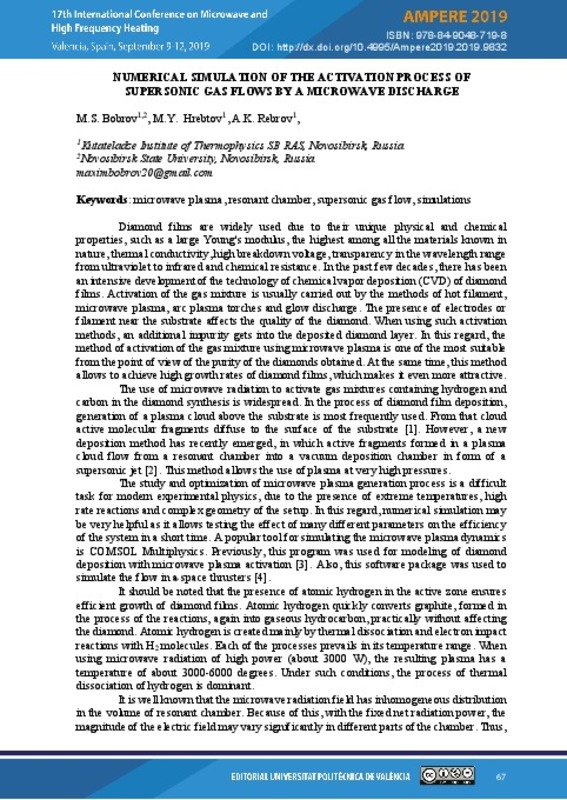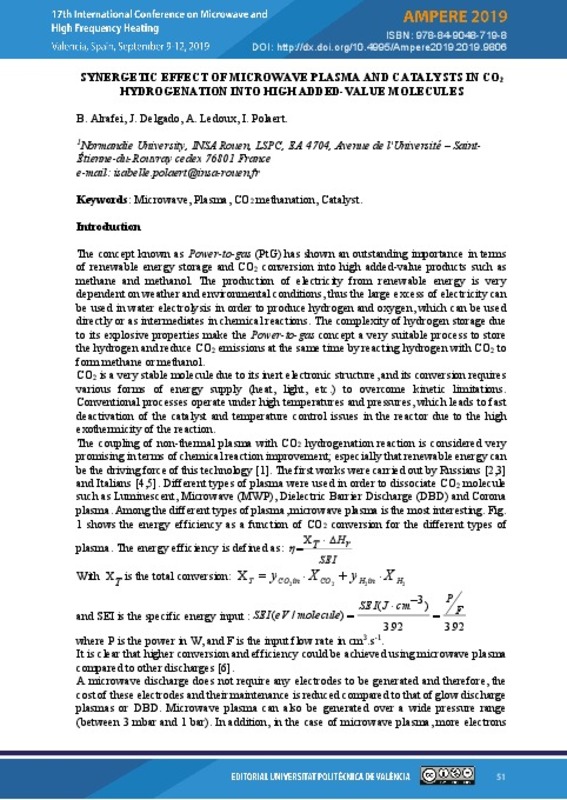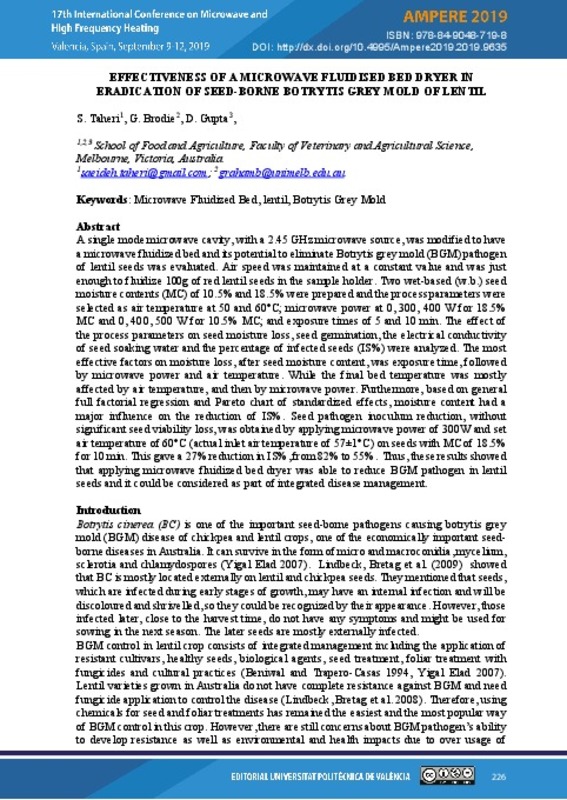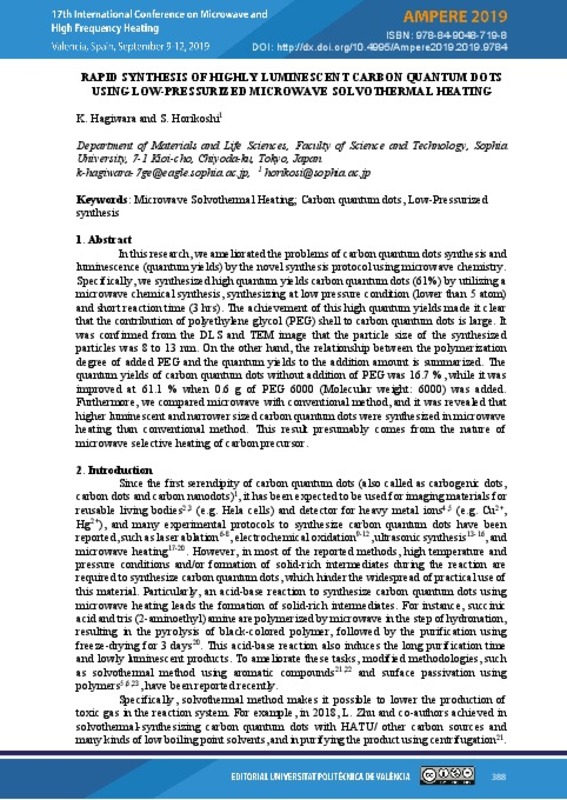JavaScript is disabled for your browser. Some features of this site may not work without it.
Buscar en RiuNet
Listar
Mi cuenta
Estadísticas
Ayuda RiuNet
Admin. UPV
Numerical simulation of the activation process of supersonic gas flows by a microwave discharge
Mostrar el registro sencillo del ítem
Ficheros en el ítem
| dc.contributor.author | Bobrov, Maxim
|
es_ES |
| dc.contributor.author | Hrebtov, Mikhail
|
es_ES |
| dc.contributor.author | Rebrov, Alexey
|
es_ES |
| dc.date.accessioned | 2019-11-11T11:50:22Z | |
| dc.date.available | 2019-11-11T11:50:22Z | |
| dc.date.issued | 2019-10-15 | |
| dc.identifier.isbn | 9788490487198 | |
| dc.identifier.uri | http://hdl.handle.net/10251/130605 | |
| dc.description.abstract | [EN] Supersonic gas flows activated by microwave discharge are commonly used to obtain thrust for spacecraft. When using a mixture of hydrocarbons and hydrogen as a working gas, the proposed method generates high-speed plasma streams with a high concentration of radicals, allowing it to be used for efficient deposition of diamond films . To optimize diamond synthesis processes, it is necessary to study the effect of various system parameters (geometrical dimensions, radiation power, pressure and others). This abstract presents a numerical simulation of the formation of high-speed gas flow activated by a microwave discharge. The conjugate problem of hydrodynamics and plasma dynamics was solved in the continuum approximation, taking into account impact ionization and thermal dissociation, due to microwave heating of the gas. The simulations were carried out in an axisymmetric formulation. The region of plasma flow formation was a cylindrical chamber (radius 5 cm, height 7 cm). At this stage, hydrogen was chosen as the working gas. The flow outlet is a hole at the center of the lower boundary with fixed pressure of 2 torr. The gas entered the domain at a constant flow rate of 20 l/min through the openings in side wall along its normal. Such flow rate sustained the mean pressure in the chamber at the level 200 torr. Microwave radiation was injected by a coaxial port located above the plasma chamber. The geometrical dimensions of the resonant chamber were selected in order to form the maximum of the electric field intensity over the gas outflow region (total deposited power 1000W). The distributions of velocity, temperature, and concentrations of all components of the hydrogen plasma were estimated. Optimal characteristics of the system were found to reach a high mole fraction of atomic hydrogen, necessary diamond deposition. | es_ES |
| dc.format.extent | 5 | es_ES |
| dc.language | Inglés | es_ES |
| dc.publisher | Editorial Universitat Politècnica de València | es_ES |
| dc.relation.ispartof | AMPERE 2019. 17th International Conference on Microwave and High Frequency Heating | es_ES |
| dc.rights | Reconocimiento - No comercial - Sin obra derivada (by-nc-nd) | es_ES |
| dc.subject | Energy Production by Microwaves | es_ES |
| dc.subject | Microwave CVD | es_ES |
| dc.subject | EM Modelling | es_ES |
| dc.subject | Microwave Material interaction | es_ES |
| dc.subject | Dielectric Properties | es_ES |
| dc.subject | Dielectric Properties Measurement | es_ES |
| dc.subject | Solid State Microwave | es_ES |
| dc.subject | Microwave Processing | es_ES |
| dc.subject | Microwave Chemistry | es_ES |
| dc.subject | Microwave applicators design | es_ES |
| dc.title | Numerical simulation of the activation process of supersonic gas flows by a microwave discharge | es_ES |
| dc.type | Capítulo de libro | es_ES |
| dc.type | Comunicación en congreso | es_ES |
| dc.identifier.doi | 10.4995/AMPERE2019.2019.9832 | |
| dc.rights.accessRights | Abierto | es_ES |
| dc.description.bibliographicCitation | Bobrov, M.; Hrebtov, M.; Rebrov, A. (2019). Numerical simulation of the activation process of supersonic gas flows by a microwave discharge. En AMPERE 2019. 17th International Conference on Microwave and High Frequency Heating. Editorial Universitat Politècnica de València. 67-71. https://doi.org/10.4995/AMPERE2019.2019.9832 | es_ES |
| dc.description.accrualMethod | OCS | es_ES |
| dc.relation.conferencename | Ampere 2019 | es_ES |
| dc.relation.conferencedate | Septiembre 09-12,2019 | es_ES |
| dc.relation.conferenceplace | Valencia, Spain | es_ES |
| dc.relation.publisherversion | http://ocs.editorial.upv.es/index.php/AMPERE2019/AMPERE2019/paper/view/9832 | es_ES |
| dc.description.upvformatpinicio | 67 | es_ES |
| dc.description.upvformatpfin | 71 | es_ES |
| dc.type.version | info:eu-repo/semantics/publishedVersion | es_ES |
| dc.relation.pasarela | OCS\9832 | es_ES |
Este ítem aparece en la(s) siguiente(s) colección(ones)
-
Ampere 2019 [66]











